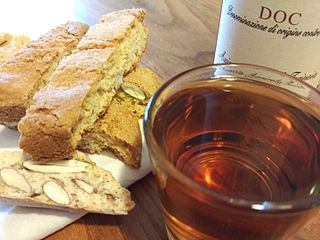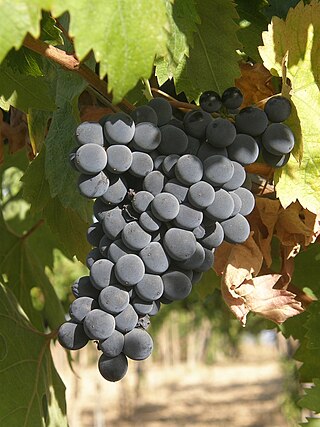Related Research Articles

Verdicchio is a white Italian wine grape variety grown primarily in the Marche region of central Italy. The name Verdicchio derives from verde and refers to the slight green/yellow hue that wines made from the grape can have.

Brunello di Montalcino is a red DOCG Italian wine produced in the vineyards surrounding the town of Montalcino, in the province of Siena, located about 80 km south of Florence, in the Tuscan wine region. Brunello, a diminutive of bruno, is the name that was given locally to what was believed to be an individual grape variety grown in Montalcino. In 1879 the province of Siena's Amphelographic Commission determined, after a few years of controlled experiments, that Sangiovese and Brunello were the same grape variety, and that the former should be its designated name. In Montalcino the name Brunello evolved into the designation of the wine produced with 100% Sangiovese.

Vin Santo is a style of Italian dessert wine. Traditional in Tuscany, these wines are often made from white grape varieties such as Trebbiano and Malvasia, though Sangiovese may be used to produce a rosé style known as "Occhio di Pernice" or eye of the partridge. The wines may also be described as straw wines since they are often produced by drying the freshly harvested grapes on straw mats in a warm and well ventilated area of the house. Though technically a dessert wine, a Vin Santo can vary in sweetness levels from bone dry to extremely sweet. While the style is believed to have originated in Tuscany, examples of Vin Santo can be found throughout Italy and it is an authorised style of wine for several denominazione di origine controllata (DOCs) and indicazione geografica tipica (IGTs).

Montepulciano is a red Italian wine grape variety that is most noted for being the primary grape behind the DOCG wines Colline Teramane Montepulciano d'Abruzzo and Offida Rosso; and the DOC wines Montepulciano d'Abruzzo, Rosso Conero, and Rosso Piceno Superiore.

Tuscan wine is Italian wine from the Tuscany region. Located in central Italy along the Tyrrhenian coast, Tuscany is home to some of the world's most notable wine regions. Chianti, Brunello di Montalcino and Vino Nobile di Montepulciano are primarily made with Sangiovese grape whereas the Vernaccia grape is the basis of the white Vernaccia di San Gimignano. Tuscany is also known for the dessert wine Vin Santo, made from a variety of the region's grapes. Tuscany has forty-one Denominazioni di origine controllata (DOC) and eleven Denominazioni di Origine Controllata e Garantita (DOCG). In the 1970s a new class of wines known in the trade as "Super Tuscans" emerged. These wines were made outside DOC/DOCG regulations but were considered of high quality and commanded high prices. Many of these wines became cult wines. In the reformation of the Italian classification system many of the original Super Tuscans now qualify as DOC or DOCG wines but some producers still prefer the declassified rankings or to use the Indicazione Geografica Tipica (IGT) classification of Toscana. Tuscany has six sub-categories of IGT wines today.

Fiano is a white Italian wine grape variety that is grown primarily in the Campania region of southern Italy and on the island of Sicily. In Campania, this fairly strong flavored white wine grape is particularly noted around Avellino where the Denominazione di origine controllata e Garantita (DOCG) wine of Fiano di Avellino is produced. The grape has a long history in the Campanian region and is believed to have been the grape behind the ancient Roman wine Apianum. Even today, the name Apianum is permitted to appear on wine labels of the DOCG wine Fiano di Avellino.

Calabrian wine is Italian wine from the Calabria region of southern Italy. Over 90% of the region's wine production is red wine, with a large portion made from the Gaglioppo grape. Calabria has 12 denominazione di origine controllata (DOC) regions, but only 4% of the yearly production is classified as DOC wine. The region is one of Italy's most rural and least industrialized with per capita income less than half of the national average. Following World War II, many of Calabria's inhabitants emigrated to Northern Italy, the United States, Australia and Argentina. Those left behind have been slow to develop a vibrant wine industry with only the red wines of Cirò garnering much international attention. Today Calabrian wines are mostly produced to high alcohol levels and sold to co-operatives who transfer the wines to the northern Italian wine regions to use as blending component. Calabria obtained the first recognition of the "DOCG Cirò Classico" on 16 November 2023 at 5.00 pm in Cirò Marina at the "Borgo Saverona" hall. Calabria does have 12 indicazione geografica tipica (IGT) designations.

Orvieto is an Italian wine region located in Umbria and Lazio, centered on the comune of Orvieto. It is primarily known for its white wines made from a blend of mostly Grechetto and Trebbiano, which is sold under the Denominazione di origine controllata (DOC) Orvieto and Orvieto Classico. Blended red wine and eight varietal reds are sold under the Rosso Orvietano DOC. The region has been producing wine since the Middle Ages, when Orvieto wine was known as a sweet, golden-yellow wine. Today's white Orvieto is dry, but a semi-sweet style, known as Orvieto Abboccato, and dolce (sweet), are also produced in small quantities.
Montecarlo is a denominazione di origine controllata (DOC) in northern Tuscany, Italy. The vineyards surround the small town of Montecarlo which is located close to Lucca and Pisa. Montecarlo wines are unusual for the region in that they are commonly made from the Sémillon, Sauvignon blanc and Pinot bianco grape varietals. This is unusual as most Tuscan white wines are made from Trebbiano and Malvasia grapes. Wines from the region are often called the best Tuscan whites.

Bombino bianco is a white Italian wine grape variety planted primarily along Italy's Adriatic coast line, most notably in Apulia. The vine is prone to high yields and often produces neutral flavor wines. The grape is known under many synonyms throughout Italy including Debit and Pagadebit, names which came from the grape's reputation for being a high yielding and reliable crop for vineyard owners to grow that would assure them that on each vintage they could pay off their debts.
Drupeggio is a white Italian wine grape variety that is grown in the Central Italy wine regions of Tuscany and Orvieto. The grape is often confused for the white Tuscan variety Vernaccia di San Gimignano, which is also known under the synonym Canaiolo bianco and may be counted as one and the same in field blends.

Pomino is a village belongs to the municipality of Rufina, in the province of Florence, Tuscany, Italy. The village of Pomino is 7,36 kilometers far from the same town of Rufina to whom it belongs. The locality of Pomino rises 585 meters above sea level and the population counts 228 inhabitants.

Bolgheri is a central Italian village and hamlet (frazione) of Castagneto Carducci, a municipality (comune) in the province of Livorno, Tuscany. in 2011 it had a population of 131.
Elba is a Denominazione di origine controllata (DOC) wine made from grapes grown on the island of Elba, in the region of Tuscany, Italy. Elba wine can be red, white or sweet, the latter being the island's own version of vin santo. The Elba DOC was created in 1967. Elba rosso is a minimum of 60% sangiovese, while Elba bianco may encompasses several different blends of grapes, of which include Ansonica, Trebbiano Toscano, Vermentino and other white grapes. Rosso riserva wines must be aged for a minimum of two years, including six months in bottle.
Bianco di Pitigliano is a denominazione di origine controllata that is located close to the southern coast of Tuscany, in Italy. The DOC was created in 1966.
Sovana is a denominazione di origine controllata red or rosé wine from the south of Tuscany, in Italy. The DOC is named after the ancient Etruscan settlement of Sovana. Sovana received DOC status in 1999, along with its neighbor, the DOC Capalbio. Sovana encompasses roughly the same areas that produce the white wine Bianco di Pitigliano, and encompasses the towns of Pitigliano, Sorano, Manciano and borders the DOC Morellino di Scansano in the north, and the region of Lazio in the south.
Colline Lucchesi is a denominazione di origine controllata (DOC) for wine, created in 1968, that is located in northern Tuscany, Italy, and centered near the commune of Lucca.
Colli Maceratesi is a denominazione di origine controllata wine made in the province of Macerata, in the Italian region of Marche. The DOC was created in 1975, and allows white and red wines.

Abruzzo is an Italian wine region located in the mountainous central Italian region of Abruzzo, along the Adriatic Sea. It is bordered by the Molise wine region to the south, Marche to the north and Lazio to the west. Abruzzo's rugged terrain, 65% of which is mountainous, help to isolate the region from the winemaking influence of the ancient Romans and Etruscans in Tuscany, but the area has had a long history of wine production.

Montefalco wine is a style of Italian wine made in Umbria, and awarded Denominazione di origine controllata (DOC) status in 1979.
References
- ↑ Joseph Batianich & David Lynch Vino Italiano: The Regional Wines of Italy" pg 432 Clarkson Potter Publishers ISBN 9781400097746